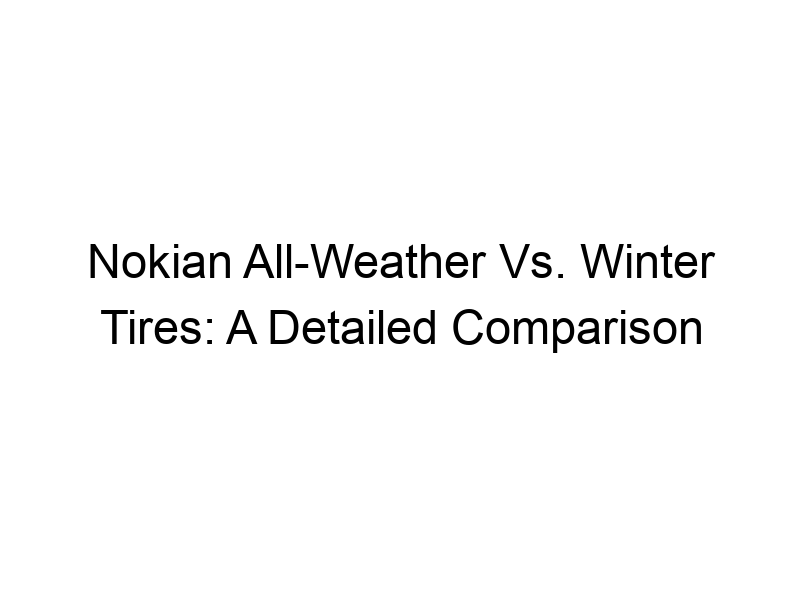Choosing the right tires is crucial for safe and efficient driving, especially in varied weather conditions. This guide delves into the key differences between Nokian all-weather tires and Nokian winter tires, helping you make an informed decision based on your needs and driving environment. We’ll explore their performance characteristics, benefits, limitations, and help you determine which type best suits your driving style and location.
All-weather tires, sometimes called all-season tires, are designed to provide adequate grip in a wider range of conditions than summer tires. They aim to offer a compromise between summer and winter performance. This means they are not as specialized as dedicated winter or summer tires and are built to work in milder snow and icy conditions, but not ideal for extreme winter weather. Nokian’s all-weather offerings incorporate advanced tread designs and rubber compounds to achieve
this balance. Their construction often includes a blend of silica and other polymers to enhance grip in both wet and dry conditions. Nokian’s emphasis on silica helps maintain flexibility even at lower temperatures, improving traction on cold, wet roads. The tread patterns are often designed with a mix of sipes (small slits) for better snow and ice grip, and larger grooves for water evacuation. However, all-weather tires are not a replacement for dedicated winter tires in severe winter climates.
Understanding Winter Tires
Winter tires, also known as snow tires, are specifically engineered for optimal performance in cold, snowy, and icy conditions. Unlike all-weather tires, winter tires utilize a softer rubber compound that remains flexible at sub-freezing temperatures. This flexibility ensures better grip on icy and snow-covered roads. The tread patterns are meticulously designed with deep grooves and numerous sipes to maximize snow and ice contact and effective expulsion of slush and water. Nokian is renowned for its winter tire technology; their tires often incorporate features like studded options (where legal) for exceptional traction on packed snow and ice. The softer rubber compound, while providing superior winter grip, leads to increased wear and reduced fuel economy compared to all-season or all-weather tires.
Nokian’s All-Weather Tire Technology
Nokian is a globally recognized tire manufacturer with a strong reputation for innovation. Their all-weather tires often feature advanced technologies designed to maximize performance in various conditions. For instance, their proprietary rubber compounds may incorporate functionalized silica, which enhances grip in both wet and dry conditions. The tread designs frequently utilize a directional pattern to efficiently channel water away from the contact patch, reducing the risk of hydroplaning. Some models also include features like optimized siping for increased snow traction and robust shoulder blocks for enhanced cornering stability. Nokian’s all-weather tires are usually geared toward drivers in regions with mild winters or those who prioritize year-round usage without the need for seasonal tire changes.
Nokian’s Winter Tire Technology
Nokian’s winter tire technology is highly advanced and focuses on maximizing grip and safety in severe winter conditions. Key technologies often include specialized rubber compounds designed to remain flexible at low temperatures, providing superior grip on snow and ice. Deep tread patterns and numerous sipes increase the contact area with the road surface, maximizing traction. Many Nokian winter tires incorporate “siping” which are tiny cuts in the tread that help to provide more biting edges for better grip in snow and ice. Some models even offer studded options for extreme winter conditions, though regulations regarding studded tires vary by region. Nokian’s expertise in winter tire technology makes their offerings a top choice for drivers in areas with harsh winter weather.
Grip and Handling Comparison
In terms of grip and handling, the difference between Nokian all-weather and winter tires is significant, especially in winter conditions. Winter tires provide superior grip on snow and ice due to their softer rubber compound and specialized tread patterns. All-weather tires offer a reasonable compromise but will likely show reduced grip in snowy or icy situations. In dry and wet conditions, the difference may be less pronounced; all-weather tires often perform quite well. However, on slick surfaces, the advantage of winter tires becomes immediately apparent, leading to shorter braking distances and better handling.
Braking Performance Comparison
Braking performance is a critical safety aspect, and winter tires significantly outperform all-weather tires on snow and ice. The softer rubber compound and optimized tread design of winter tires allow for better interaction with the road surface, resulting in shorter stopping distances. This crucial difference in braking performance highlights the importance of choosing the right tire for the prevailing conditions. All-weather tires will brake adequately in normal conditions but might fall short in snowy or icy situations, potentially leading to extended stopping distances and increased safety risks.
Fuel Efficiency Comparison
All-weather tires tend to offer slightly better fuel efficiency than winter tires. This is primarily due to the softer rubber compound used in winter tires, which increases rolling resistance. The increased rolling resistance translates to slightly lower fuel economy compared to all-weather tires. The difference, however, is usually minimal and often outweighed by the improved safety and traction offered by winter tires in harsh winter conditions. Ultimately, the choice between fuel efficiency and safety should depend on individual priorities and driving conditions.
Durability and Tread Life Comparison
Winter tires generally have shorter tread life compared to all-weather tires. This is a direct consequence of the softer rubber compound designed for optimal winter grip. The softer material wears down more quickly than the harder compound in all-weather tires. This is a trade-off between performance and longevity. However, the enhanced safety and improved traction provided by winter tires often justify the reduced tread life, particularly for drivers in areas with significant snowfall.
Cost Comparison
Generally, winter tires have a higher initial cost compared to all-weather tires. This is due to the specialized materials and manufacturing processes involved in producing winter tires with their advanced rubber compounds and intricate tread designs. While the higher initial cost is a factor, the improved safety and potentially reduced repair costs from accidents averted due to superior winter grip often offset the difference.
Maintenance and Storage
Seasonal tire changes require appropriate storage for the out-of-season tires. This can necessitate additional costs for storage space or tire-specific storage solutions. Alternatively, a set of wheels for both seasonal tires can ease seasonal changes and negate storage concerns. All-weather tires eliminate the need for seasonal changes and their associated storage and maintenance expenses, making them a convenient option for drivers.
Environmental Impact Comparison
The environmental impact of tire manufacturing and disposal remains relevant. Choosing tires that offer extended tread life can lessen the overall environmental impact. All-weather tires, with their potentially longer lifespan, may present a slightly lower environmental impact compared to winter tires needing seasonal replacements. However, this needs to be weighed against other factors like driving behavior and the safety benefits of using optimal tires for specific conditions.
Legal Considerations
Some regions have regulations concerning tire usage, particularly during winter months. In some areas, winter tires are mandatory during periods of heavy snowfall or icy conditions. Before purchasing tires, confirm that the choice aligns with your region’s legal requirements. Understanding local laws about studded tires and required tread depth is crucial for drivers.
Choosing the Right Tires for Your Needs
The best choice between Nokian all-weather and winter tires depends on several factors. Consider your geographical location, typical winter weather conditions, driving habits, and budget. Drivers in areas with mild winters or those prioritizing year-round use with no major winter conditions might find all-weather tires suitable. However, those in regions experiencing heavy snowfall, icy conditions, or frequent sub-freezing temperatures should strongly consider winter tires for enhanced safety and improved traction.
Nokian Tire Selection Guide
Nokian offers a range of both all-weather and winter tires, each designed with specific performance characteristics. Carefully review Nokian’s product specifications and select the tire that best aligns with your vehicle, driving style, and geographical location. Consider tire size, speed rating, and load index when selecting your tires. It is advisable to consult with a tire professional to determine the optimal tire for your specific requirements.
Understanding Tire Labeling
Tire sidewalls contain essential information, including tire size, load index, and speed rating. Understanding these labels is critical when selecting tires. Furthermore, look for performance ratings on grip, fuel efficiency, and noise levels. These ratings help guide the tire selection based on your specific priorities.
Frequently Asked Questions
What are the key differences between Nokian all-weather and winter tires?
The primary difference lies in their rubber compounds and tread designs. Winter tires use a softer rubber compound that remains flexible in cold temperatures, providing superior grip on snow and ice. All-weather tires use a harder compound for longer lifespan but compromise grip in extreme winter conditions.
Are all-weather tires suitable for all climates?
No. All-weather tires are a compromise. They’re suitable for regions with mild winters, but areas with heavy snowfall or frequent icy conditions require dedicated winter tires for optimal safety.
When should I switch to winter tires?
The ideal time to switch to winter tires is before the first snowfall or when temperatures consistently fall below 7°C (45°F). Check your local weather forecasts to determine the optimal time.
How long do Nokian winter tires last?
The lifespan of Nokian winter tires depends on driving habits, weather conditions, and tire care. Generally, they last 2-3 winters, but proper maintenance and driving can extend this.
Do Nokian all-weather tires require special maintenance?
No more than standard tires. Routine tire pressure checks, rotations, and inspections are recommended. All-weather tires benefit from correct inflation pressures for optimal fuel efficiency and performance.
Can I use studded tires on any road?
Studded tires are not allowed on all roads, especially during warmer months. Check your local regulations before using studded tires, as damage to road surfaces and excessive noise are significant concerns.
What is the best way to store tires out of season?
Store tires in a cool, dry place away from direct sunlight and extreme temperatures. Use tire bags or racks to prevent damage and preserve tire quality.
Are studded Nokian tires worth the extra cost?
In extremely icy conditions, studded tires significantly improve safety and traction, justifying the higher cost for drivers in areas experiencing frequent extreme winters. The increased grip outweighs the expense for those who need the highest level of winter traction.
Final Thoughts
Choosing between Nokian all-weather and winter tires is a crucial decision affecting both safety and driving experience. Carefully consider your climate, driving habits, and budget when making your selection. All-weather tires offer convenience and year-round use for milder climates, while Nokian’s advanced winter tires provide superior grip and safety in harsh winter conditions. Remember to consult with a tire professional to determine the best option for your specific needs and to ensure compliance with all applicable regulations. Prioritize safety; the right tires can make all the difference.

